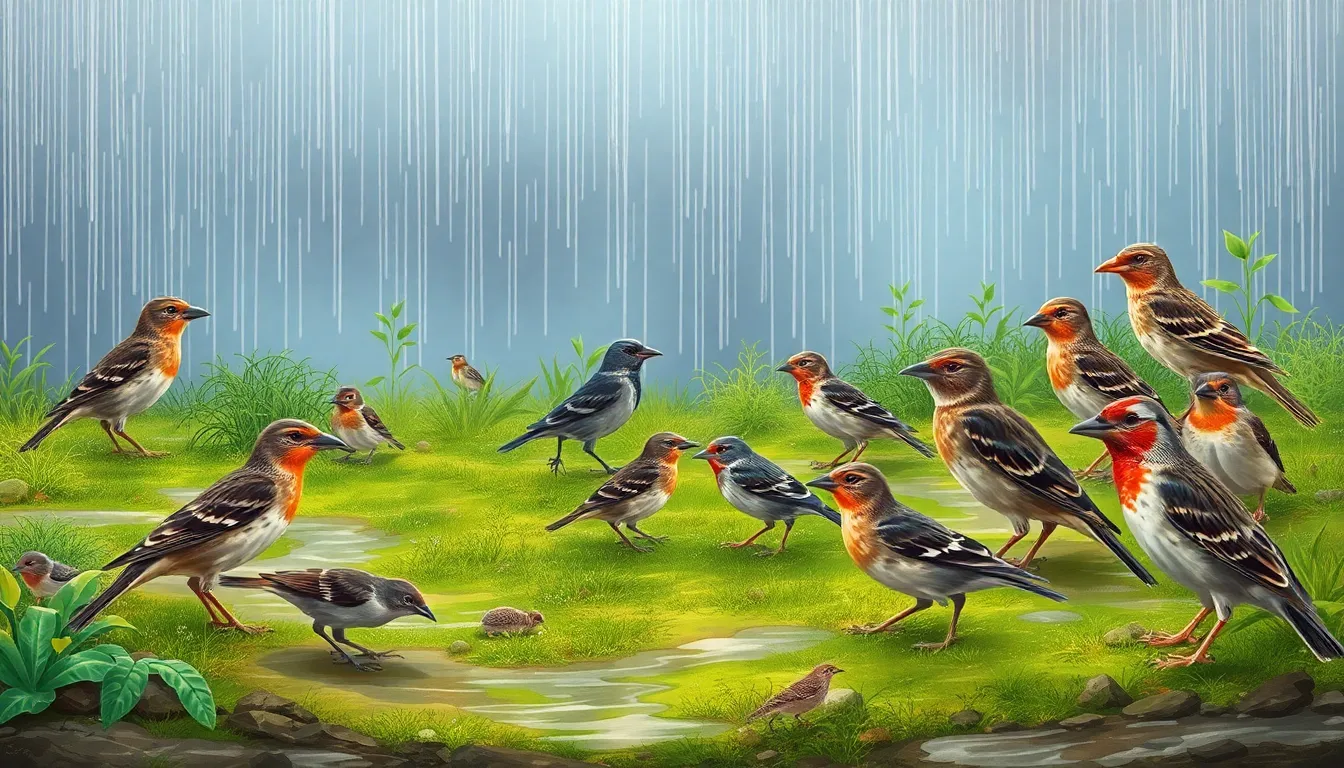Rainfall and bird beaks might seem like an odd pairing, but they’re more connected than you’d think. Imagine a world where birds adapt their beaks not just for food but also for the whims of weather. It’s like nature’s version of a reality show where only the most resourceful survive the storm. Dive into the fascinating relationship between rainfall patterns and avian anatomy, and discover how these feathered friends have evolved to thrive in changing climates.
Table of Contents
ToggleOverview of Rainfall and Bird Beaks Gizmo
The connection between rainfall and bird beaks reveals crucial insights into evolutionary biology. Various bird species exhibit distinct beak shapes, optimized for different feeding strategies. Changes in rainfall impact food availability, driving adaptations in beak morphology. For instance, during periods of heavy rainfall, certain birds may evolve longer, narrower beaks to access food sources hidden under water or mud.
Observations across regions demonstrate this adaptive response, with birds thriving in specific climate conditions. Research indicates that areas with fluctuating rainfall patterns encourage greater beak diversity among birds. Consequently, birds in wetter climates tend to develop different feeding adaptations than those in arid regions.
Moreover, analysis of beak size reveals trends related to rainfall. Larger beaks often allow birds to consume larger prey, which may become more abundant with increased rainfall. Conversely, smaller beaks might enable birds to extract seeds or insects from damp vegetation, showcasing how resource availability influences avian design.
Data from various studies support these findings, illustrating the dynamic relationship between climate factors and bird anatomy. Patterns of rainfall significantly shape the evolutionary pathways of avian species, making this an essential area of study within ecology. Understanding these relationships provides valuable implications for conservation efforts, as climate change continues to alter weather patterns. In summary, rainfall acts as a significant driver of beak evolution, emphasizing the importance of environmental conditions in shaping wildlife adaptation.
Importance of Rainfall in Ecosystems

Rainfall plays a vital role in shaping ecosystems, significantly influencing bird species’ survival and adaptation. The availability of water affects food sources, nesting sites, and migration patterns.
Effects on Bird Populations
Rainfall patterns directly impact bird populations. Increased moisture leads to abundant flora, supporting various insect and seed species. Species such as sparrows and finches thrive in these environments, experiencing population growth. On the contrary, drought conditions create a scarcity of resources. Fewer food options result in lower survival rates for many bird species. Studies show that regions with consistent rainfall enjoy diverse and stable bird populations compared to area experiencing extreme fluctuations.
Adaptations in Bird Anatomy
Birds adapt anatomically to shifting rainfall conditions. Changes in beak structure exemplify this adaptation. For instance, birds in wet regions often develop longer, more slender beaks designed for foraging in muddy areas. In contrast, arid environments foster birds with shorter, sturdier beaks that can process tough seeds. This anatomical variation allows birds to maximize food acquisition. Observing the correlation between rainfall and beak size highlights how environmental conditions drive evolutionary changes in avian species. Researchers emphasize this adaptability as critical for ongoing avian survival amid changing climates.
Understanding the Gizmo Tool
The Gizmo tool simplifies the exploration of how rainfall affects bird beak evolution. Users can engage with interactive elements to visualize data connections.
Features of the Gizmo
Gizmo offers various features designed to enhance learning. Users can analyze rainfall data alongside bird beak measurements. Detailed graphs track changes in bird populations correlated with rainfall fluctuations. Interactive simulations present different feeding strategies based on beak shapes. Additionally, comparison tools allow users to examine distinct bird species and their adaptations in response to their environments. These features promote a deeper understanding of the relationship between climate and avian anatomy.
How to Use the Gizmo
Using the Gizmo involves a series of straightforward steps. First, select the parameters for rainfall and bird species. Next, explore visualizations that depict data trends over time. Engage in simulations to observe changes in beak shapes related to varied rainfall patterns. Users can also manipulate environmental factors to see immediate effects on food availability and bird survival. Finally, assessing results through the provided quizzes reinforces the learning experience. Effective navigation ensures a comprehensive grasp of the climate-bird anatomy link.
Analyzing the Results
This section examines the data collected through the Gizmo tool, emphasizing the relationship between rainfall and bird beak evolution.
Data Interpretation
Data from various studies support the understanding of beak diversity in relation to rainfall. Changes in beak size and shape correlate directly with food availability affected by weather patterns. For instance, regions with higher rainfall often show birds adapting longer, narrower beaks to reach food sources beneath water or mud. Observational data suggest that species in these wet environments tend to have different feeding strategies compared to those in arid areas. Statistical analyses reveal a clear connection between increased rainfall and the prevalence of larger prey, highlighting how anatomical adaptations facilitate survival. Ultimately, this information enhances comprehension of how climate factors influence real-time evolutionary processes.
Insights Gained from the Activity
Insights gained through using the Gizmo tool provide valuable lessons about avian adaptation. By analyzing rainfall data alongside beak measurements, users discover the intricate ways birds respond to environmental changes. The activity demonstrates that species with longer, slender beaks are more successful in wet conditions, while those with shorter, sturdier beaks thrive in dry climates. Engaging with simulations allows for an exploration of potential future scenarios, showing how variable rainfall affects food resource distribution. These findings illustrate the importance of adaptive traits in helping bird populations flourish or decline as climates shift. Overall, through interactive learning, deeper awareness of the ecological dynamics emerges.
Understanding the intricate relationship between rainfall and bird beak evolution reveals the remarkable adaptability of avian species. As climate patterns shift birds continuously adjust their physical traits to optimize survival and feeding strategies. The Gizmo tool enhances this exploration by offering interactive insights into how these adaptations manifest in different environments.
Through data visualization and simulation users can appreciate the direct impact of rainfall on bird populations and their beak morphology. This knowledge underscores the importance of conservation efforts in the face of climate change. By recognizing how environmental factors shape avian anatomy we can better appreciate the delicate balance of ecosystems and the resilience of nature.








